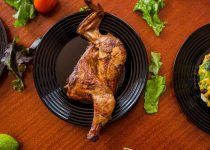How Long to Cook Ribeye Roast on Ronco Rotisserie
Are you ready to elevate your cooking game with a succulent ribeye roast on your Ronco rotisserie?
The secret to achieving that perfect balance of juicy tenderness and mouthwatering flavor lies in mastering the cooking time and temperature.
But fear not, because we've got you covered with expert tips and guidelines to ensure your ribeye roast comes out just the way you like it.
So, let's dive into the art of rotisserie cooking and unlock the key to a show-stopping ribeye roast that will have everyone asking for seconds.
Choosing the Right Ribeye Roast
When selecting a ribeye roast for your Ronco Rotisserie, opt for a well-marbled cut to ensure a juicy and flavorful result. The marbling in the meat, those little streaks of fat, add richness and moisture as it cooks. Look for a roast with even distribution of fat throughout the meat for the best outcome.
Once you have chosen the perfect cut, consider your seasoning preferences. A simple salt and pepper rub can enhance the natural flavor of the meat, but feel free to get creative with your favorite herbs and spices.
Additionally, consider using rotisserie accessories such as temperature probes to ensure that your ribeye roast is cooked to perfection. A temperature probe allows you to monitor the internal temperature of the roast, ensuring that it reaches the desired level of doneness. This handy tool takes the guesswork out of the cooking process, giving you confidence in achieving a mouthwatering result.
Preparing the Ribeye Roast for Rotisserie
To prepare the ribeye roast for the rotisserie, begin by generously seasoning the meat with your favorite blend of herbs and spices, ensuring to coat the entire surface for maximum flavor infusion. This is a crucial step in ensuring a delicious outcome. You can use a variety of seasoning techniques such as dry rubs, marinades, or simply salt and pepper to enhance the flavor profile. For an added depth of flavor, consider incorporating garlic powder, onion powder, smoked paprika, or even a touch of cayenne pepper for a hint of heat. Experimenting with different flavor options can elevate the taste of your ribeye roast, so feel free to get creative with your seasonings.
When preparing the ribeye roast for the rotisserie, it's important to trim any excess fat to prevent flare-ups and ensure even cooking. Tie the roast with kitchen twine if it's irregularly shaped to help it cook evenly. Additionally, patting the roast dry before seasoning will help the spices adhere better and form a flavorful crust during the rotisserie process.
These meat preparation and rotisserie tips will set the stage for a mouthwatering ribeye roast that will surely impress your guests.
Setting Up Your Ronco Rotisserie
Ready to get started with your Ronco Rotisserie?
Let's walk through the simple process of assembling the rotisserie.
Then we'll cover the power and timer settings.
With these key points in mind, you'll be all set to begin cooking your delicious ribeye roast to perfection.
Rotisserie Assembly
Setting up your Ronco Rotisserie is a straightforward process that will have you ready to start cooking in no time. To assemble your rotisserie, follow these simple steps:
- First, ensure that all the parts are included in the package.
- Next, carefully read the instruction manual to understand the assembly process.
- Then, start assembling the parts following the step-by-step guide provided.
- If you encounter any issues during assembly, refer to the troubleshooting section in the manual for solutions.
As you assemble your Ronco Rotisserie, remember to handle the parts with care and take your time to ensure everything is put together correctly. Once assembled, you'll be all set to start enjoying delicious rotisserie-cooked meals.
Power and Timer Settings
When using your Ronco Rotisserie, it's important to familiarize yourself with the power and timer settings to ensure perfect cooking results every time. The table below outlines the temperature control and recommended rotisserie maintenance for your convenience.
| Power Setting | Temperature (°F) | Timer (minutes) |
|---|---|---|
| Low | 250 | 90 |
| Medium | 300 | 75 |
| High | 350 | 60 |
To maintain your rotisserie, regularly clean the interior and exterior with a damp cloth and mild detergent. Ensure the rotisserie is completely dry before use. Additionally, inspect the heating elements for any debris and remove it to prevent any potential issues. By following these temperature control and maintenance guidelines, you'll ensure that your Ronco Rotisserie continues to deliver delicious meals for years to come.
Cooking Time and Temperature Guidelines
For perfect results, ensure that the ribeye roast reaches an internal temperature of 135°F and allow it to cook for approximately 20 minutes per pound on the rotisserie.
Achieving the right internal temperature is crucial for a perfectly cooked ribeye roast. Here are some helpful guidelines to ensure your ribeye roast turns out just the way you like it:
- Use a meat thermometer to accurately monitor the internal temperature of the roast.
- Let the ribeye roast rest for 15-20 minutes after cooking to allow the juices to redistribute for a more flavorful and tender result.
- Consider seasoning the roast with your favorite herbs and spices before placing it on the rotisserie for added flavor.
- Always preheat your rotisserie before placing the roast inside to ensure even cooking and delicious results.
Monitoring the Roast for Doneness
To ensure the ribeye roast is cooked to your desired level of doneness, use a meat thermometer to monitor the internal temperature throughout the cooking process. This is the most reliable way to ensure a perfectly cooked roast. Insert the meat thermometer into the thickest part of the roast, making sure not to touch any bones, as this can give an inaccurate reading.
For a medium-rare roast, the internal temperature should reach 135°F (57°C), while a medium roast requires 145°F (63°C). If you prefer your roast medium-well, aim for 150°F (66°C), and for a well-done roast, the internal temperature should be around 160°F (71°C).
In addition to using a meat thermometer, visual cues can also help determine the doneness of the roast. A medium-rare roast will have a warm, red center, while a medium roast will have a slightly pink center. Keep an eye on the color of the juices as well; clear juices indicate a well-done roast.
Remember to keep the rotisserie well-maintained to ensure even cooking and troubleshoot any issues that may arise during the process. Happy cooking!
Resting and Carving the Cooked Ribeye Roast
After monitoring the ribeye roast for doneness, the next step is allowing it to rest before carving to ensure a juicy and flavorful outcome. The resting period is crucial as it allows the juices to redistribute, resulting in a more tender and flavorful roast.
Here's how to properly rest and carve your cooked ribeye roast:
- Resting: Once the roast is done, remove it from the rotisserie and tent it loosely with aluminum foil. Let it rest for about 15-20 minutes. This resting period allows the juices to evenly distribute throughout the roast, ensuring a moist and tender result.
- Carving Techniques: When carving the ribeye roast, it's important to slice it against the grain for maximum tenderness. Use a sharp carving knife and slice the roast into thin, even pieces. This ensures that each slice is tender and flavorful.
- Serving Suggestions: Consider serving the ribeye roast with a side of horseradish sauce or a flavorful jus to complement the rich, beefy flavor.
- Leftovers: If you have leftovers, store them properly in an airtight container in the refrigerator. The leftover roast can be used for delicious sandwiches or added to soups and stews for extra flavor.
Frequently Asked Questions
Can I Use a Different Type of Roast in the Ronco Rotisserie, or Does It Have to Be Specifically a Ribeye Roast?
Yes, you can use different types of roast in the Ronco rotisserie. It's compatible with various cuts. Just adjust cooking times and methods based on the type of roast you're using for delicious results.
What Type of Seasoning or Marinade Works Best for a Ribeye Roast in the Ronco Rotisserie?
For the best seasoning, consider a flavorful rub or marinade for your ribeye roast on the Ronco rotisserie. Experiment with different combinations to find the perfect seasoning that suits your taste preferences. Enjoy the process!
Can I Use the Ronco Rotisserie to Cook Vegetables or Other Side Dishes at the Same Time as the Ribeye Roast?
Yes, you can use the Ronco rotisserie to cook vegetables and other side dishes at the same time as the ribeye roast. It's a great way to combine flavors and maximize cooking efficiency.
Is It Possible to Overcook a Ribeye Roast in the Ronco Rotisserie, and How Can I Prevent This From Happening?
To prevent overcooking your ribeye roast on the Ronco Rotisserie, make sure to monitor the temperature regularly. Adjust the cooking time based on the roast's internal temperature to ensure it's cooked to perfection. Keep an eye on it!
Are There Any Specific Carving Techniques or Tips for Slicing the Ribeye Roast After It Has Been Cooked in the Ronco Rotisserie?
When it comes to carving techniques and slicing tips for a ribeye roast cooked in the Ronco rotisserie, make sure to let the roast rest before slicing to retain its juices and use a sharp carving knife for clean, even slices.



